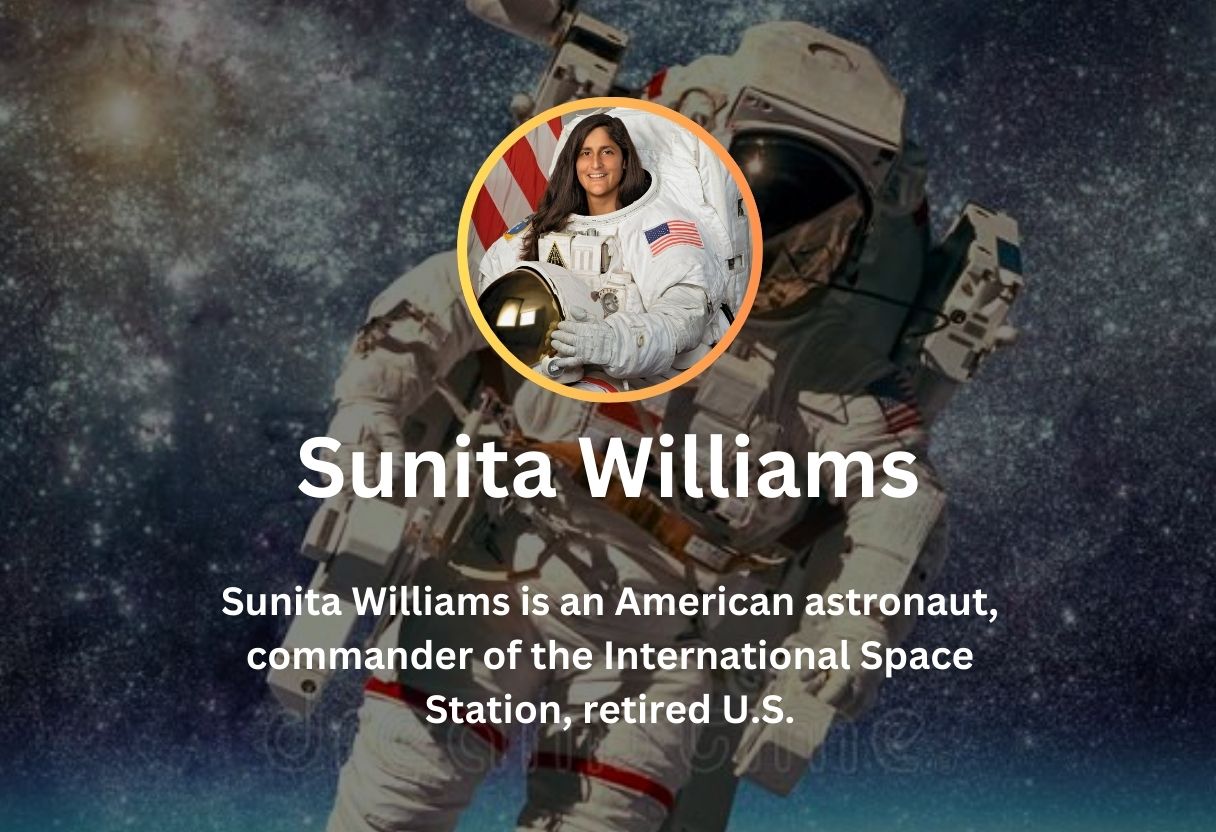Early Life and Education

Sunita Lyn Williams was born on September 19, 1965, in Euclid, Ohio, USA, to Deepak Pandya and Bonnie Pandya. Her father was an Indian-American neuroanatomist from Gujarat, while her mother had Slovenian heritage. She grew up in Needham, Massachusetts, where she developed a keen interest in science, engineering, and adventure.
Williams attended Needham High School and later earned a Bachelor of Science in Physical Science from the United States Naval Academy in 1987. Her thirst for knowledge and leadership skills led her to pursue a Master of Science in Engineering Management from the Florida Institute of Technology in 1995.
Sunita Lyn Williams spent her childhood in Needham, Massachusetts, where she was raised in a culturally diverse environment. Her father, Deepak Pandya, an Indian-American neuroanatomist, and her mother, Bonnie Pandya, of Slovenian heritage, played a significant role in shaping her upbringing. Growing up in a household that valued education and curiosity, Williams developed a keen interest in science, technology, and exploration from an early age.
As a child, she was known for her adventurous spirit and love for the outdoors. She enjoyed swimming, running, and participating in various sports, which later contributed to her strong physical endurance—an essential trait for an astronaut. Williams also had a deep fascination with aviation and space, although she did not initially aspire to become an astronaut.
During her school years at Needham High School, Williams excelled academically and demonstrated leadership qualities. She was disciplined and hardworking, traits that later helped her succeed in the United States Naval Academy and eventually in NASA. Her upbringing instilled in her the values of perseverance and dedication, which played a crucial role in her journey toward becoming an astronaut and setting records in space exploration.
Military Career

Commissioned as an Ensign in the United States Navy in 1987, Williams embarked on a distinguished military career. She trained as a helicopter pilot, flying the CH-46 Sea Knight, and participated in overseas deployments to the Mediterranean, Red Sea, and the Persian Gulf. Her exemplary performance led to her selection as a Naval Test Pilot in 1993, where she tested various aircraft, accumulating over 3,000 flight hours across more than 30 different aircraft types.
During her early years in the Navy, Williams was assigned to Helicopter Combat Support Squadron 8 (HC-8) based in Norfolk, Virginia. She played a critical role in supporting naval operations, including search-and-rescue missions, transportation of personnel and supplies, and assisting in combat and humanitarian missions. Her time aboard naval ships provided her with valuable experience working in high-pressure environments, a skill that later benefited her space missions.
After becoming a Naval Test Pilot, Williams was stationed at the Naval Air Warfare Center Aircraft Division in Patuxent River, Maryland. There, she worked on evaluating the performance of various helicopters and fixed-wing aircraft, ensuring they met operational and safety standards. Her role required not only exceptional piloting skills but also a deep understanding of aerodynamics, engineering, and problem-solving.
In 1998, she was selected to become an astronaut, bringing her distinguished military career to a new frontier—space exploration. Williams’ experience as a test pilot and her ability to operate complex aircraft made her an ideal candidate for NASA. Over her career, she earned numerous military honors, including the Defense Superior Service Medal, the Legion of Merit, and the Navy Commendation Medal, reflecting her dedication and contributions to both the Navy and aerospace exploration.
NASA Career

In 1998, Williams was selected as a NASA astronaut, marking the beginning of a series of significant contributions to space exploration.
First Spaceflight: STS-116/Expedition 14/15 (2006-2007)
Williams launched aboard Space Shuttle Discovery on December 9, 2006, joining the International Space Station (ISS) as a flight engineer for Expeditions 14 and 15. During her 195-day mission, she conducted four spacewalks totaling 29 hours and 17 minutes, setting a record for female astronauts at the time. Notably, she ran the first marathon by an astronaut in orbit, completing the Boston Marathon on the ISS treadmill.
Second Spaceflight: Expedition 32/33 (2012)

On July 15, 2012, Williams launched aboard Soyuz TMA-05M to the ISS, where she served as a flight engineer for Expedition 32 and commander for Expedition 33. She performed three additional spacewalks, bringing her total EVA time to 50 hours and 40 minutes, further solidifying her status as one of the most experienced female spacewalkers.
Recent Mission: Boeing Crew Flight Test/SpaceX Crew-9 (2024-2025)
In June 2024, Williams embarked on the Boeing Crew Flight Test mission to the ISS. Initially planned as an eight-day mission, technical issues with the spacecraft’s propulsion system extended her stay to over nine months. NASA arranged for her return aboard SpaceX Crew-9, and she safely returned to Earth in March 2025. This prolonged mission brought her total time in space to 608 days, making her one of the most experienced astronauts in terms of cumulative space time.
Health and Rehabilitation
Extended exposure to microgravity poses challenges such as muscle atrophy, bone density loss, and fluid redistribution. Upon return, Williams underwent comprehensive medical evaluations and rehabilitation to readjust to Earth’s gravity. Her resilience and positive outlook have been instrumental in her recovery process.
Personal Life
Williams is married to Michael J. Williams, a former police officer. Her family has been a steadfast source of support throughout her career, providing encouragement during both her triumphs and challenges.
Honors and Awards
Williams has received numerous accolades, including the Defense Superior Service Medal, Legion of Merit, and NASA Space Flight Medal. In 2008, she was awarded the Padma Bhushan, India’s third-highest civilian award, recognizing her contributions to space exploration and her role as a trailblazer for women in STEM fields.
Boeing’s Crew Flight Test

Sunita Williams’s recent mission was initially planned as a brief test flight of Boeing’s Starliner spacecraft. Launched on June 5, 2024, alongside fellow astronaut Barry “Butch” Wilmore, the mission aimed to evaluate the Starliner’s performance during a short-duration stay at the International Space Station (ISS).
Source: NASA
However, technical issues arose with the Starliner’s propulsion system, rendering it unsafe for the crew’s return journey. In response, NASA made the decision to bring the Starliner back to Earth without crew onboard to mitigate risks.
Source: NASA
Consequently, Williams and Wilmore remained aboard the ISS, contributing to ongoing scientific research and station operations. Their mission extended from the planned eight days to 286 days, during which they conducted over 150 experiments and accumulated approximately 900 hours of research.
Source: THE ECONOMIC TIMES
Williams’s decision to stay was driven by her commitment to the mission’s objectives and the safety protocols established by NASA. The extended duration provided valuable data on long-term space habitation, benefiting future missions. She assumed command of the ISS on September 22, 2024, demonstrating leadership during this unplanned extension.
Source: SPACE.COM
The astronauts returned to Earth aboard SpaceX’s Crew Dragon capsule, which safely splashed down off the coast of Florida on March 18, 2025.
Source: REUTERS
Upon return, Williams and Wilmore began a comprehensive rehabilitation process to readjust to Earth’s gravity, addressing effects such as muscle atrophy and bone density loss.
Source: THE US SUN
This mission underscores the complexities of space exploration and the adaptability required of astronauts when faced with unforeseen challenges.
Sunita Williams and Barry “Butch” Wilmore returned to Earth. Here’s a clearer breakdown of their return journey:
- Return Decision – Due to technical issues with the Starliner spacecraft, NASA decided that it was unsafe for the crew to return using it. Instead, the Starliner was brought back to Earth without astronauts.
- Extended Stay at ISS – Because of this issue, Williams and Wilmore had to extend their mission from the planned 8 days to 286 days.
- Final Return to Earth – They returned aboard SpaceX’s Crew Dragon capsule, which safely splashed down off the coast of Florida on March 18, 2025.
- Post-Landing Recovery – After landing, they began a rehabilitation process to help them adjust back to Earth’s gravity, as extended time in space causes muscle atrophy and bone density loss.









